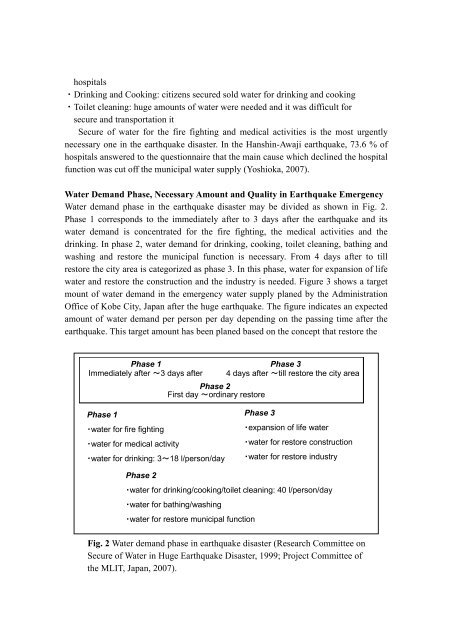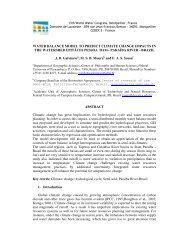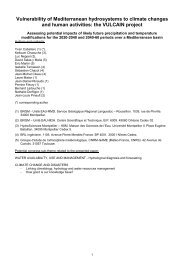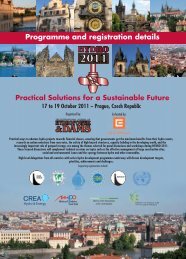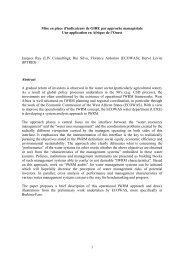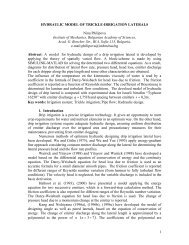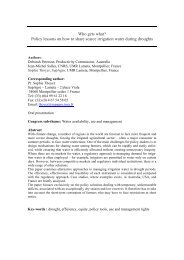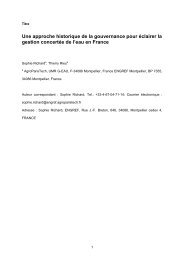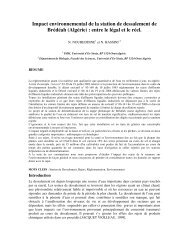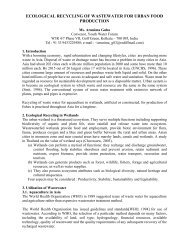Groundwater Use in Earthquake Emergency: A Case Study ... - IWRA
Groundwater Use in Earthquake Emergency: A Case Study ... - IWRA
Groundwater Use in Earthquake Emergency: A Case Study ... - IWRA
You also want an ePaper? Increase the reach of your titles
YUMPU automatically turns print PDFs into web optimized ePapers that Google loves.
hospitals・Dr<strong>in</strong>k<strong>in</strong>g and Cook<strong>in</strong>g: citizens secured sold water for dr<strong>in</strong>k<strong>in</strong>g and cook<strong>in</strong>g・Toilet clean<strong>in</strong>g: huge amounts of water were needed and it was difficult forsecure and transportation itSecure of water for the fire fight<strong>in</strong>g and medical activities is the most urgentlynecessary one <strong>in</strong> the earthquake disaster. In the Hansh<strong>in</strong>-Awaji earthquake, 73.6 % ofhospitals answered to the questionnaire that the ma<strong>in</strong> cause which decl<strong>in</strong>ed the hospitalfunction was cut off the municipal water supply (Yoshioka, 2007).Water Demand Phase, Necessary Amount and Quality <strong>in</strong> <strong>Earthquake</strong> <strong>Emergency</strong>Water demand phase <strong>in</strong> the earthquake disaster may be divided as shown <strong>in</strong> Fig. 2.Phase 1 corresponds to the immediately after to 3 days after the earthquake and itswater demand is concentrated for the fire fight<strong>in</strong>g, the medical activities and thedr<strong>in</strong>k<strong>in</strong>g. In phase 2, water demand for dr<strong>in</strong>k<strong>in</strong>g, cook<strong>in</strong>g, toilet clean<strong>in</strong>g, bath<strong>in</strong>g andwash<strong>in</strong>g and restore the municipal function is necessary. From 4 days after to tillrestore the city area is categorized as phase 3. In this phase, water for expansion of lifewater and restore the construction and the <strong>in</strong>dustry is needed. Figure 3 shows a targetmount of water demand <strong>in</strong> the emergency water supply planed by the Adm<strong>in</strong>istrationOffice of Kobe City, Japan after the huge earthquake. The figure <strong>in</strong>dicates an expectedamount of water demand per person per day depend<strong>in</strong>g on the pass<strong>in</strong>g time after theearthquake. This target amount has been planed based on the concept that restore thePhase 1Phase 3Immediately after ~3 days after 4 days after ~till restore the city areaPhase 2First day ~ord<strong>in</strong>ary restorePhase 1・water for fire fight<strong>in</strong>g・water for medical activity・water for dr<strong>in</strong>k<strong>in</strong>g: 3~18 l/person/dayPhase 3・expansion of life water・water for restore construction・water for restore <strong>in</strong>dustryPhase 2・water for dr<strong>in</strong>k<strong>in</strong>g/cook<strong>in</strong>g/toilet clean<strong>in</strong>g: 40 l/person/day・water for bath<strong>in</strong>g/wash<strong>in</strong>g・water for restore municipal functionFig. 2 Water demand phase <strong>in</strong> earthquake disaster (Research Committee onSecure of Water <strong>in</strong> Huge <strong>Earthquake</strong> Disaster, 1999; Project Committee ofthe MLIT, Japan, 2007).


